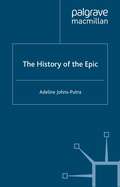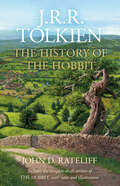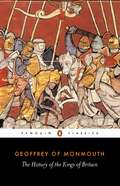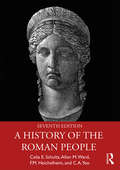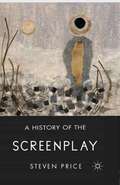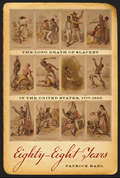- Table View
- List View
A History of the English Language
by Norman BlakeUnlike other histories of the English language, this introduction cuts away traditional divisions into old, middle and modern English to chart the rise of and changes in standard English. It covers the English and historical background, changes in phonology, vocabulary and syntax, and offers close analyses of individual texts of English from a wide range of periods. The final chapter focuses on the place of English as a world language and the growing array of the varieties of English spoken today. A useful appendix gives definitions of technical terms and phonetic symbols.
The History of the English Language: A Sourcebook
by David BurnleyThis second edition of The History of the English Language- A Sourcebook provides a comprehensive and accessible guide to the origins and development of the English language. First published in 1992, the book contains over fifty illustrative passages, drawn from the oldest English to the twentieth century. The passages are contextualised by individual introductions and grouped into the traditional periods of Old English, Early Middle English, Later Middle English, Early Modern English and Modern English. These periods are connected by brief essays explaining the major linguistic developments associated with each period, to produce a continuous outline history.For this new edition Professor Burnley has expanded the outline of linguistic features at each of the main chronological divisions and included more selections and illustrations. A new section has also been included to illustrate the language of advertising from the 18th century to the present. The book will be of general interest to all those interested in the origins and development of the English language, and in particular to students and teachers of the history of the English language at A-level and university.
The History of the English Language: A Sourcebook
by David BurnleyThis second edition of The History of the English Language- A Sourcebook provides a comprehensive and accessible guide to the origins and development of the English language. First published in 1992, the book contains over fifty illustrative passages, drawn from the oldest English to the twentieth century. The passages are contextualised by individual introductions and grouped into the traditional periods of Old English, Early Middle English, Later Middle English, Early Modern English and Modern English. These periods are connected by brief essays explaining the major linguistic developments associated with each period, to produce a continuous outline history.For this new edition Professor Burnley has expanded the outline of linguistic features at each of the main chronological divisions and included more selections and illustrations. A new section has also been included to illustrate the language of advertising from the 18th century to the present. The book will be of general interest to all those interested in the origins and development of the English language, and in particular to students and teachers of the history of the English language at A-level and university.
The History of the Epic (Palgrave Histories of Literature)
by A. Johns-PutraThis book presents a history of the epic from the classical age to the present day. It deals not just with the well-know epics of antiquity and the Renaissance, but also pursues developments in more recent literature and film. It offers an exploration of the changes that have taken place in the genre from Homer to Hollywood.
A History of the French Language
by Peter RickardThis well-established and popular book provides students with all the linguistic background they need for studying any period of French literature. For the second edition the text has been revised and updated throughout, and the two final chapters on contemporary French, and its position as a world language, have been completely rewritten. Starting with a brief description of the Vulgar Latin spoken in Gaul, and the earliest recorded forms of French, Peter Rickard traces the development of the language through the later Middle Ages and Renaissance to show how it became standardized in a near modern form in the seventeenth and eighteenth centuries.
A History of the French Language
by Peter RickardThis well-established and popular book provides students with all the linguistic background they need for studying any period of French literature. For the second edition the text has been revised and updated throughout, and the two final chapters on contemporary French, and its position as a world language, have been completely rewritten. Starting with a brief description of the Vulgar Latin spoken in Gaul, and the earliest recorded forms of French, Peter Rickard traces the development of the language through the later Middle Ages and Renaissance to show how it became standardized in a near modern form in the seventeenth and eighteenth centuries.
A History of the French Language Through Texts
by Wendy Ayres-BennettThis new history of the French language allows the reader to see how the language has evolved for themselves. It combines texts and extracts with a readable and detailed commentary allowing the language to be viewed both synchronically and diachronically.Core texts range from the ninth century to the present day highlight central features of the language, whilst a range of shorter texts illustrate particular points.The inclusion of non-literary, as well as literary texts serves to illustrate some of the many varieties of French whether in legal, scientific, epistolatory, administrative or liturgical or in more popular domains, including attempts to represent spoken usage.This is essential reading for the undergraduate student of French.
A History of the French Language Through Texts
by Wendy Ayres-BennettThis new history of the French language allows the reader to see how the language has evolved for themselves. It combines texts and extracts with a readable and detailed commentary allowing the language to be viewed both synchronically and diachronically.Core texts range from the ninth century to the present day highlight central features of the language, whilst a range of shorter texts illustrate particular points.The inclusion of non-literary, as well as literary texts serves to illustrate some of the many varieties of French whether in legal, scientific, epistolatory, administrative or liturgical or in more popular domains, including attempts to represent spoken usage.This is essential reading for the undergraduate student of French.
The History of the Hobbit: Mr Baggins And Return To Bag-end
by J. R. Tolkien John D. RateliffA major new examination of how J.R.R.Tolkien came to write his original masterpiece ‘The Hobbit’, including his complete unpublished draft version of the story, and many little-known illustrations and previously unpublished maps by Tolkien himself.
A History of the Irish Language: From the Norman Invasion to Independence
by Aidan DoyleIn this book, Aidan Doyle traces the history of the Irish language from the time of the Norman invasion at the end of the 12th century to independence in 1922, combining political, cultural, and linguistic history. The book is divided into seven main chapters that focus on a specific period in the history of the language; they each begin with a discussion of the external history and position of the Irish language in the period, before moving on to investigate the important internal changes that took place at that time. A History of the Irish Language makes available for the first time material that has previously been inaccessible to students and scholars who cannot read Irish, and will be a valuable resource not only for undergraduate students of the language, but for all those interested in Irish history and culture.
The History of the Kings of Britain: An Edition And Translation Of The De Gestis Britonum (historia Regum Brittannie) (Arthurian Studies #Volume 69)
by Lewis Thorpe Geoffrey Of MonmouthCompleted in 1136, The History of the Kings of Britain traces the story of the realm from its supposed foundation by Brutus to the coming of the Saxons some two thousand years later. Vividly portraying legendary and semi-legendary figures such as Lear, Cymbeline, Merlin the magician and the most famous of all British heroes, King Arthur, it is as much myth as it is history and its veracity was questioned by other medieval writers. But Geoffrey of Monmouth's powerful evocation of illustrious men and deeds captured the imagination of subsequent generations, and his influence can be traced through the works of Malory, Shakespeare, Dryden and Tennyson.
A History of the Modern British Ghost Story
by S. HayGhost stories are always in conversation with novelistic modes with which they are contemporary. This book examines examples from Sir Walter Scott, Charles Dickens, Henry James and Rudyard Kipling, amongst others, to the end of the twentieth century, looking at how they address empire, class, property, history and trauma.
A History of the Münster Anabaptists: Inner Emigration and the Third Reich: A Critical Edition of Friedrich Reck-Malleczewen’s Bockelson: A Tale of Mass Insanity
by George Von Der Lippe V. Reck-MalleczewenA defining work in the "Inner Emigration" literary movement, Friedrich Reck-Malleczewen's History of the Münster Anabaptists was written in 1937 as a criticism of the Nazi regime. This English translation includes documents, scholarly essays, and a detailed introduction.
A History of the Roman People
by Celia E. Schultz Allen M. Ward F. M. Heichelheim C. A. YeoA History of the Roman People offers students a comprehensive, up-to-date, readable introduction to the whole span of Roman history. Richly illustrated, this fully updated volume takes readers through the mists of Roman prehistory and a survey of the peoples of pre-Roman Italy to a balanced, thoughtful account of the complexities of the Roman Republic, its evolution into a full-fledged empire, and its ultimate decline. This latest edition enhances the political narrative with explorations of elements of daily life in the Roman world. New features in this edition include: Addition of boxes that expand on interesting elements of Roman culture mentioned only in passing in the main text. The visual arrangement of the text helps students bear in mind what is supplemental to the central narrative Increased emphasis on the contributions of women to Roman society and in religious matters Incorporation of recent archaeological finds and current debates A History of the Roman People is an excellent introduction for those with no background in Roman history. Its clear, accessible language makes it perfect for undergraduate readers in courses on Roman history and Roman culture. More experienced students wanting to expand their knowledge will also find it a rich resource for the full sweep of Roman antiquity.
A History of the Scots Language
by Robert McColl MillarThis book provides a thorough yet approachable history of the Scots language, a close relative of Standard English with around 1.5 million speakers in Scotland and several thousand in Ireland, according to the 2011 census. Despite the long history of Scots as a language of high literature, it has been somewhat neglected and has often been treated as a dialect of Standard English. In this book, Robert McColl Millar explores both sociolinguistic and structural developments in the history of Scots, bringing together these two threads of analysis to offer a better understanding of linguistic change. The first half of the book tracks the development of Scots from its beginnings to the modern period, while chapters in the second half offer detailed descriptions of Scots historical phonology and morphosyntax, and of the historical development of Scots lexis. A History of the Scots Language will be a valuable resource for undergraduate and graduate students of the modern and historical Scots language, but will also be of interest to those studying the history of English and other Germanic languages.
A History of the Scots Language
by Robert McColl MillarThis book provides a thorough yet approachable history of the Scots language, a close relative of Standard English with around 1.5 million speakers in Scotland and several thousand in Ireland, according to the 2011 census. Despite the long history of Scots as a language of high literature, it has been somewhat neglected and has often been treated as a dialect of Standard English. In this book, Robert McColl Millar explores both sociolinguistic and structural developments in the history of Scots, bringing together these two threads of analysis to offer a better understanding of linguistic change. The first half of the book tracks the development of Scots from its beginnings to the modern period, while chapters in the second half offer detailed descriptions of Scots historical phonology and morphosyntax, and of the historical development of Scots lexis. A History of the Scots Language will be a valuable resource for undergraduate and graduate students of the modern and historical Scots language, but will also be of interest to those studying the history of English and other Germanic languages.
A History of the Screenplay
by S. PriceThe screenplay is currently the focus of extensive critical re-evaluation, however, as yet there has been no comprehensive study of its historical development. International in scope and placing emphasis on the development and variety of screenplay texts themselves, this book will be an important and innovative addition to the current literature.
A History of the Spanish Novel
The origins of the Spanish novel date back to the early picaresque novels and Don Quixote, in the sixteenth and seventeenth centuries, and the history of the genre in Spain presents the reader with such iconic works as Galdós's Fortunata and Jacinta, Clarín's La Regenta, or Unamuno's Mist. A History of the Spanish Novel traces the developments of Spanish prose fiction in order to offer a comprehensive and detailed account of this important literary tradition. It opens with an introductory chapter that examines the evolution of the novel in Spain, with particular attention to the rise and emergence of the novel as a genre, during the sixteenth and seventeenth centuries, and the bearing of Golden-Age fiction in later novelists of all periods. The introduction contextualises the Spanish novel in the circumstances and milestones of Spain's history, and in the wider setting of European literature. The volume is comprised of chapters presented diachronically, from the sixteenth to the twenty-first century and others concerned with specific traditions (the chivalric romance, the picaresque, the modernist novel, the avant-gardist novel) and with some of the most salient authors (Cervantes, Zayas, Galdós, and Baroja). A History of the Spanish Novel takes the reader across the centuries to reveal the captivating life of the Spanish novel tradition, in all its splendour, and its phenomenal contribution to Western literature.
A History of the Tajiks: Iranians of the East (Library Of Middle East History Ser.)
by Richard FoltzIn this comprehensive and up to date history, from prehistoric proto-Indo-Iranian times to the post-Soviet period, Richard Foltz traces the complex linguistic, cultural and political history of the Tajiks, a Persian-speaking Iranian ethnic group from the modern-day Central Asian states of Tajikistan, Afghanistan, and Uzbekistan. In eight chapters, the author explores the revitalisation of Persian culture under the Samanid Empire in the Tajik heartlands of historical Khorasan and Transoxiana; analyses the evolution of the politics of Tajik identity; and traces the history of the ethnic Tajik diaspora today.
A History of the Tajiks: Iranians of the East
by Richard FoltzIn this comprehensive and up to date history, from prehistoric proto-Indo-Iranian times to the post-Soviet period, Richard Foltz traces the complex linguistic, cultural and political history of the Tajiks, a Persian-speaking Iranian ethnic group from the modern-day Central Asian states of Tajikistan, Afghanistan, and Uzbekistan. In eight chapters, the author explores the revitalisation of Persian culture under the Samanid Empire in the Tajik heartlands of historical Khorasan and Transoxiana; analyses the evolution of the politics of Tajik identity; and traces the history of the ethnic Tajik diaspora today.
A History of the Tajiks: Iranians of the East
by Richard FoltzIn this comprehensive and up to date history, from prehistoric proto-Indo-Iranian times to the post-Soviet period, Richard Foltz traces the complex linguistic, cultural and political history of the Tajiks, a Persian-speaking Iranian ethnic group from the modern-day Central Asian states of Tajikistan, Afghanistan, and Uzbekistan. In eight chapters, the author explores the revitalisation of Persian culture under the Samanid Empire in the Tajik heartlands of historical Khorasan and Transoxiana; analyses the evolution of the politics of Tajik identity; and traces the history of the ethnic Tajik diaspora today.This revised edition includes a new chapter on the Tajiks' situation in Tajikistan, Afghanistan and Uzbekistan since 2018, covering notably the effects of the Taliban's return to power in August 2021 and the COVID pandemic in all three countries, as well as border clashes with Kyrgyzstan.
A History of the Tajiks: Iranians of the East
by Richard FoltzIn this comprehensive and up to date history, from prehistoric proto-Indo-Iranian times to the post-Soviet period, Richard Foltz traces the complex linguistic, cultural and political history of the Tajiks, a Persian-speaking Iranian ethnic group from the modern-day Central Asian states of Tajikistan, Afghanistan, and Uzbekistan. In eight chapters, the author explores the revitalisation of Persian culture under the Samanid Empire in the Tajik heartlands of historical Khorasan and Transoxiana; analyses the evolution of the politics of Tajik identity; and traces the history of the ethnic Tajik diaspora today.This revised edition includes a new chapter on the Tajiks' situation in Tajikistan, Afghanistan and Uzbekistan since 2018, covering notably the effects of the Taliban's return to power in August 2021 and the COVID pandemic in all three countries, as well as border clashes with Kyrgyzstan.
The History of Thyssen: Family, Industry and Culture in the 20th Century
by Günther Schulz Margit Szöllösi-JanzeAs a result of a multi-volume research project, funded by the Thyssen Foundations (Stiftung zur Industriegeschichte Thyssen and Fritz Thyssen Stiftung), ten books were published that served to greatly advance the available knowledge on the Thyssen family and their companies. The results of this project are summarized in this volume which provides both an explanation of how the project was conceptualized and executed and a detailed case study of a family and their business during the late-nineteenth and twentieth centuries. It explains the development of both whilst addressing issues such as patriarchal succession; gender roles in the family; wealthy lifestyles in international communities of aristocrats and diplomats; operating across national legislation, institutions, and policies; and discussions of labor and capital. In doing so it connects corporate and family history to provide an all-inclusive view of the development of a business.
The History of Thyssen: Family, Industry and Culture in the 20th Century
by Günther Schulz Margit Szöllösi-JanzeAs a result of a multi-volume research project, funded by the Thyssen Foundations (Stiftung zur Industriegeschichte Thyssen and Fritz Thyssen Stiftung), ten books were published that served to greatly advance the available knowledge on the Thyssen family and their companies. The results of this project are summarized in this volume which provides both an explanation of how the project was conceptualized and executed and a detailed case study of a family and their business during the late-nineteenth and twentieth centuries. It explains the development of both whilst addressing issues such as patriarchal succession; gender roles in the family; wealthy lifestyles in international communities of aristocrats and diplomats; operating across national legislation, institutions, and policies; and discussions of labor and capital. In doing so it connects corporate and family history to provide an all-inclusive view of the development of a business.
The History of Thyssen: Family, Industry and Culture in the 20th Century
by Günther Schulz Margit Szöllösi-JanzeAs a result of a multi-volume research project, funded by the Thyssen Foundations (Stiftung zur Industriegeschichte Thyssen and Fritz Thyssen Stiftung), ten books were published that served to greatly advance the available knowledge on the Thyssen family and their companies. The results of this project are summarized in this volume which provides both an explanation of how the project was conceptualized and executed and a detailed case study of a family and their business during the late-nineteenth and twentieth centuries. It explains the development of both whilst addressing issues such as patriarchal succession; gender roles in the family; wealthy lifestyles in international communities of aristocrats and diplomats; operating across national legislation, institutions, and policies; and discussions of labor and capital. In doing so it connects corporate and family history to provide an all-inclusive view of the development of a business.


